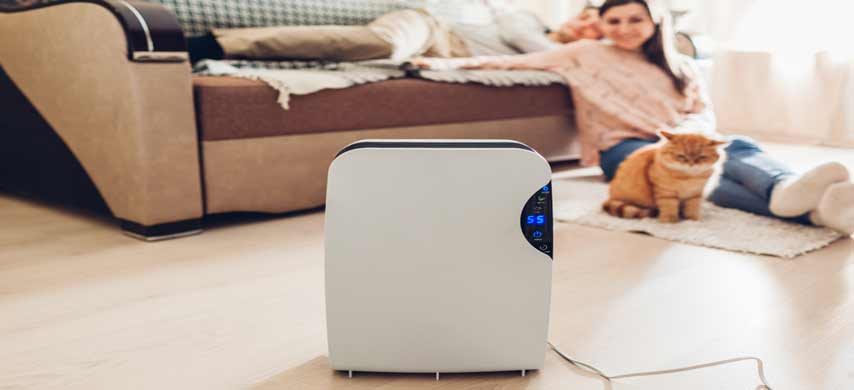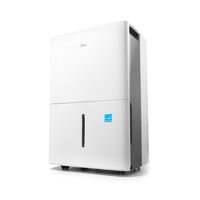How Does A Dehumidifier Work
 Home & Kitchen
Home & KitchenAre you considering getting a dehumidifier for your home or business? Do you want to reduce allergies, improve air quality, prevent mold growth, and protect and prolong the lifespan of your furniture and belonging? Then understanding how a dehumidifier works can help.
Whether this is all new information for you or just brushing up on the basics, read on and learn how dehumidifiers can help make your space more comfortable and with fresh air.
How Does a Dehumidifier Work?
Dehumidifiers regulate the humidity in a room, aiming for a relative humidity of 30-50%. By extracting excess moisture from the indoor air, they create an environment where mold, dust mites, and other allergens have difficulty thriving, as stated by the National Asthma Council.
Here's a detailed description of how dehumidifiers work:
- Air intake: The dehumidifier draws in humid air from the surrounding environment.
- Cooling: The humid air is directed over a set of cold coils or a refrigeration system within the dehumidifier. This cooling process causes the air to lose its ability to hold moisture.
- Condensation: As the air cools, the excess moisture in the form of water vapor begins to condense. The moisture collects on the cold coils or a condensation plate within the dehumidifier.
- Water collection: The condensed water droplets are collected in a reservoir or channeled through a drain hose. The water is removed outside the dehumidifier. Some models offer options for continuous drainage.
- Reheating: After extracting moisture, the dehumidifier reheats the air to its original temperature before releasing it back into the room. It helps maintain a comfortable ambient temperature and indoor air quality.
- Humidity control: The dehumidifier continuously repeats this process, extracting moisture from the indoor humidity in the air, until the desired humidity level is reached. Some dehumidifiers have built-in humidistats that allow you to set and maintain specific humidity levels.
Types of Dehumidifiers
There are several types of dehumidifiers available on the market, each with its own unique working mechanism.
Here are the main types:
- Refrigeration Dehumidifiers: This is the most common type of dehumidifier, also known as the compressor dehumidifier. It uses a refrigeration system with coils to cool the air and extract moisture. The air is then reheated and released back into the room. The refrigerant dehumidifier is effective in various environments and temperature ranges.
- Desiccant Dehumidifiers: Desiccant dehumidifier uses desiccant material, such as silica gel, to absorb moisture from the air. The moist air passes over the desiccant, which attracts and holds the moisture. These dehumidifiers are often used in colder temperatures or specific applications where low humidity is required, like drying laundry or protecting sensitive equipment.
- Thermoelectric Dehumidifiers: Also known as Peltier dehumidifiers, they use a solid-state thermoelectric module to cool the air and remove moisture. These dehumidifiers are compact, quiet, and energy-efficient but have a lower moisture removal capacity compared to compressor-based models. They are suitable for small spaces or mild humidity conditions.
- Whole-House/In-Duct Dehumidifiers: These dehumidifiers are integrated into the HVAC (Heating, Ventilation, and Air Conditioning) system of a house. They remove moisture from the air as it circulates through the ductwork, providing centralized dehumidification for the entire home.
- Mini/Portable Dehumidifiers: Mini or portable dehumidifiers are smaller units designed for localized use in specific areas like bedrooms, bathrooms, closets, or small rooms. They offer convenience and mobility, often with a reservoir that needs to be manually emptied.
Using a Dehumidifier
Using a dehumidifier offers numerous benefits for creating a comfortable and healthier indoor environment. Reducing excess humidity helps prevent mold and mildew growth, musty odors, and damage to furniture or other items.
To maximize its effectiveness, place the dehumidifier in areas prone to dampness, such as basements, bathrooms, or laundry rooms.
Set the desired humidity level on the unit's control panel or use the built-in humidistat, if available. Regularly empty the water reservoir or connect a drain hose for continuous operation.
Some models offer additional features like air filtration to improve indoor air quality. Remember to clean or replace filters as needed.
Do dehumidifiers really work?
Dehumidifiers are very effective in reducing humidity levels and addressing moisture-related issues. They work by extracting excess moisture from the air, creating a more comfortable and healthier environment.
Dehumidifiers have proven to be particularly beneficial in areas with high humidity, such as basements or bathrooms. They help prevent mold growth, reduce musty odors, and inhibit the proliferation of dust mites and other allergens.
It's important to choose a dehumidifier with the appropriate capacity for the space and follow proper maintenance procedures, such as emptying the water reservoir and cleaning or replacing filters and other dehumidifier parts when needed.
When used correctly, dehumidifiers are indeed effective in controlling humidity and improving overall indoor conditions.
Do dehumidifiers use a lot of electricity?
The electricity consumption of dehumidifiers can vary depending on factors such as the size and capacity of the unit, the humidity level in the space, and the duration of usage.
Dehumidifiers are designed to be energy-efficient, but larger models or those operating in more challenging conditions may consume more power. Look for dehumidifiers with an Energy Star rating because they meet specific efficiency guidelines.
Using the dehumidifier in a well-insulated space and setting it to the appropriate humidity level can help optimize energy usage.
Is a Dehumidifier Worth It?
A dehumidifier is worth it in many situations. It offers numerous benefits, such as creating a more comfortable living environment, preventing mold and mildew growth, reducing musty odors, and protecting your belongings from moisture damage.
If you live in a humid climate or have areas in your home prone to excess moisture, a dehumidifier can significantly improve indoor air quality and overall comfort. It can also help alleviate allergies and respiratory issues caused by mold spores and dust mites.
While there are costs to consider, the long-term advantages of a dehumidifier make it a worthwhile investment for maintaining a healthier and more pleasant living space.
Premium offer:
According to our experts, the Midea 1,500 Sq. Ft. Energy Star Certified Dehumidifier is worth its premium price. With its ability to efficiently control humidity levels in basements, large rooms, and bathrooms, it ensures a comfortable and healthier living environment.
The 22-pint capacity, previously 30 pints, is more than sufficient for any needs. The reusable air filter provides cleaner air and helps reduce ongoing expenses on replacements.
The dehumidifier operates quietly, allowing you to enjoy peace and tranquility. Considering its outstanding performance, energy efficiency, and durability, the Midea Dehumidifier is a worthwhile investment for the health and well-being of both yourself and your family.
Best Offer::
Our experts find the performance of the COLAZE DH01 Dehumidifier impressive. With a coverage of 2500 square feet and a moisture removal capacity of 30 pints, it eliminates excess humidity in your home, whether it's the basement, bedroom, or bathroom.
The convenience of the included drain hose ensures continuous operation without the need for frequent manual emptying. The auto defrosts and overflow protection features provide added peace of mind during colder temperatures.
The timer and drying function allows for customized dehumidification according to your specific needs. With a spacious water tank, you will rarely have to worry about emptying it.
Offer Up To $70:
The Gocheer Upgraded Dehumidifier can transform any place in your home into a dry and comfortable space. Our experts find its impressive coverage of up to 800 square feet effectively tackles excess humidity and prevents mold growth.
The included drain hose makes maintenance hassle-free. The water tank is generous in size, reducing the frequency of emptying. You will be surprised how quietly it operates, allowing you to enjoy your peace and quiet.
This portable dehumidifier is very comfortable so you can move it around the house. If you're looking for a reliable and efficient solution to combat moisture and on a budget, this one will be a great dehumidifier for your needs.
Budget Friendly Offer - Under $50:
The Makayla Dehumidifier is a budget-friendly offer, making it an excellent value for its performance. Our experts find this compact unit effectively removes moisture from any home, wardrobe, and bathroom, creating a more comfortable living space.
The auto shut-off feature gives me peace of mind, and the seven colors lights add a pleasant ambiance. It operates quietly, ensuring a peaceful environment.
As you can see, understanding how a dehumidifier works can demystify its remarkable ability to create a more comfortable and healthier indoor environment.
That is why our experts prepared this complete guide for you, and hope it will help you to choose the best dehumidifier for your needs and improve the air you and your family breathe.



